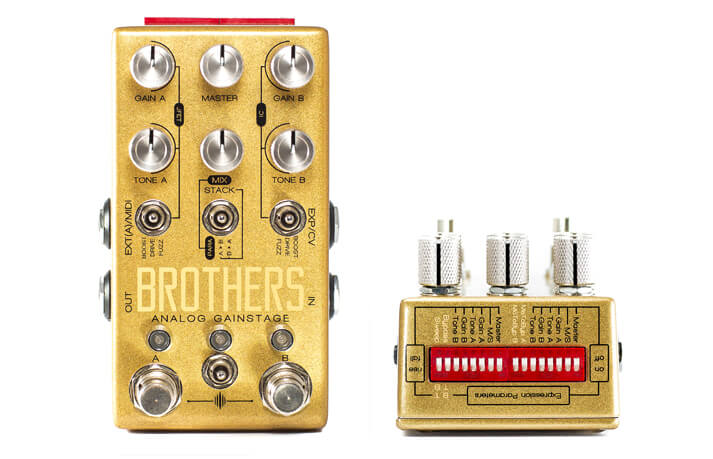There are pedals that could be called “tweaker’s delights,” and then there’s the Chase Bliss Audio Brothers pedal.
With 2 channels (A & B) that can be set for boost, drive or fuzz, it can handle those tones easily but the circuits are done a bit differently, with channel A being JFET based, and Channel B using an IC type design. These are two of the most popular pedal circuit designs, and gives each one a nice, different tonal response.
There is a neat mix control, engaging both A and B channels, and setting the center toggle to PARA, enables the blending of the two, via the mix control. There is also the option to select which channel comes first in the chain; if you like your boost before a fuzz, or a boost after the drive, as well as any variation, it’s covered here! Routing becomes a fun game of “which option sounds better to me?”
With pretty much every tonal switching and control option covered in a thoughtful manner, how does it sound? Simply put, it’s fantastic. The fuzz on both JFET and IC sides are well done, with enough brightness to cut through, and react well to volume changes on the fly. Pairing them with the boost functions really allow things to keep from getting stuck in the mix. The drive sides have plenty of sparkle and bite at lower settings, and short of dark metal, should have enough usable gain for leads that are tight and responsive, as well as rich chunky rhythm parts that still have definition.

The bank of DIP switches on the back really opens up even more functionality — such as a momentary function; step on a footswitch, and hold it, and it’s on. Step off it, and it disengages. For a player who might want a quick lick to throw in between the vocals, without making it sound like switching channels, this is your unit.
Connect an expression pedal, and pretty much every variable control can be controlled by it. True bypass or buffered? Yep, it’s player’s choice. Going even further, settings can be saved for each channel, by pressing and holding the footswitch, and for those players who really want to go there, it can be connected to a MIDI switcher, as well.
At a street price of $349, it’s not cheap, but it goes far beyond the usual 2-button “drive/boost” pedals, and with pretty much every tonal option and routing variation you could imagine. Of course, it sounds amazing, and this could save a lot of space on a pedalboard, all while gaining buckets more functionality and options.
PROS:
every tonal section option available, great selection of tones.
CONS:
slightly pricey.
PRICE:
$349
